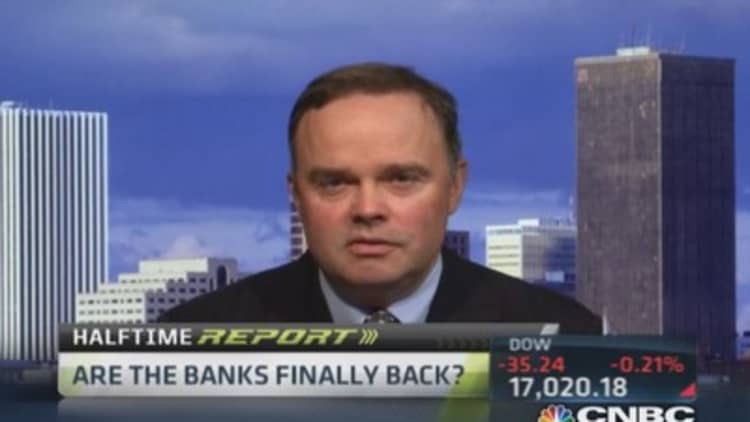For the first time in recent memory, financials investors are judging bank earnings by Main Street borrowing versus Wall Street's trading activity.
On Wednesday, Bank of America executives were pressed by analysts to determine whether loan growth—a reflection of consumers' and companies' readiness to borrow—was at an "inflection point." Chief Financial Officer Bruce Thompson wasn't willing to call a watershed just yet, saying loans will continue chugging along with the economy.
The sentiment is important, as scant volatility and low interest rates have paralyzed banks' trading powerhouses, which have seen double-digit declines for fixed-income desks, traditionally some of the most active. Bank of America touted a 5 percent rise in revenue in that unit (as trading of mortgages and municipal bonds picked up), though that becomes a 14 percent drop when certain valuation adjustments are included.
Bank of America is in good company: JPMorgan Chase, Goldman Sachs and Citigroup also reported double-digit declines in fixed-income trading revenues for the second quarter. The difference, though, is that other parts of their business model outshined trading. Goldman CFO Harvey Schwartz called a bottom in fixed income, but also pointed to wealth management and investing and lending as a source of major earnings growth.
Read MoreAIG in $650M settlement with Bank of America over mortgages
While Goldman isn't traditionally thought of as a consumer-facing bank, its "lending" unit saw a 46 percent jump in revenue. Schwartz said he'd even consider acquisitions in the bank's wealth management business—one of its only units where individuals, not corporations, are the client—if the deal added to shareholder value.
So what, then, should analysts make of a continued slump in trading?
Nothing, according to JPMorgan CEO Jamie Dimon, who said predicting it is "a waste of time."

In JPMorgan's case, the bank is seeing client assets rise sharply, and consumer confidence spurs more spending across credit and debit cards. CFO Marianne Lake said she sees high single-digit growth in spending on items like groceries and gas, and double-digit growth in spending on discretionary items like travel and retail.
"Across the board, consumers are spending healthily in all categories," Lake told investors on a conference call.
While JP Morgan brass lamented the slowdown in mortgage borrowing, other borrowing—in small business, commercial real-estate and by high net-worth clients—saw marked increases.
"Consumers, middle market companies and corporations are in increasingly good financial shape," Dimon said.
Read MoreWhy we all need banks
Pittsburgh-based PNC and Minneapolis-based U.S. Bancorp would agree. The former saw loans grow nearly 6 percent, the latter nearly 7 percent. But no matter how much loans grow, banks won't see that boost the bottom line until yields start going up. Low yields make each loan less profitable and drive down margins; for that reason, PNC and US Bancorp shares sank in trading.
The silver lining: A margin squeeze for the banks is temporary, but underlying loan growth would be a harbinger for positive data to come.
—By CNBC's Kayla Tausche

